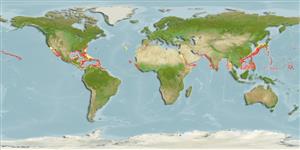Environment: milieu / climate zone / depth range / distribution range
বাস্তুসংস্থান
সামুদ্রিক সমুদতলে ভাসমান বেনথোপেলাজিক; গভীরতার পরিসীমা 128 - 885 m (Ref. 4503), usually 200 - 400 m (Ref. 4503). Deep-water; 38°N - 7°N
Eastern Atlantic: Gulf of Guinea, off Senegal, and off South Africa; reported from Namibia (Ref. 4255). Western Atlantic: Virginia, USA to northern South America (Ref. 7251). Also found in Brazil (Ref. 47377). Western Pacific: Japan, Philippines, New Caledonia, between Fiji and Tonga Islands, Australia (Ref. 7300), New Zealand (Ref. 5755). Indian Ocean (Ref. 47377).
আকৃতি / ওজন / Age
Maturity: Lm ? range ? - ? cm
Max length : 17.5 cm TL পুরুষ/ লিঙ্গ অনিধর্ারিত ; (Ref. 39376)
পৃষ্ঠীয় কাঁটা (মোট ) : 5 - 6; পৃষ্ঠীয় নরম পাখনা দন্ড (মোট ) : 27 - 30; পায়ূ কাঁটা : 2; পায়ূর নরম পাখনা্তুন্ড: 27 - 29. Body silvery, with round black spots; anterior pelvic rays and end of caudal fin black (Ref. 4255). First dorsal spine minute, 2nd the longest; 1st anal spine markedly long, subequal to orbit (Ref. 13608). Gill rakers rudimentary.
Found on the continental slope. Benthic species (Ref. 75154). Minimum depth from Ref. 58018.
Life cycle and mating behavior
Maturities | প্রজনন | Spawnings | Egg(s) | Fecundities | শুককীট
Karrer, C., 1990. Grammicolepididae. p. 634-636. In J.C. Quero, J.C. Hureau, C. Karrer, A. Post and L. Saldanha (eds.) Check-list of the fishes of the eastern tropical Atlantic (CLOFETA). JNICT, Lisbon; SEI, Paris; and UNESCO, Paris. Vol. 2. (Ref. 4503)
IUCN Red List Status (Ref. 130435)
Threat to humans
Harmless
Human uses
মৎস্য: আকর্ষণবিহীণ
হাতিয়ার
Special reports
Download XML
ইন্টারনেট সুত্র
Estimates based on models
Preferred temperature (Ref.
123201): 9.6 - 19.4, mean 13.3 °C (based on 233 cells).
Phylogenetic diversity index (Ref.
82804): PD
50 = 1.1250 [Uniqueness, from 0.5 = low to 2.0 = high].
Bayesian length-weight: a=0.01905 (0.00917 - 0.03958), b=2.94 (2.75 - 3.13), in cm total length, based on LWR estimates for this species & (Sub)family-body (Ref.
93245).
ট্রফিক পর্যায়ে (Ref.
69278): 3.6 ±0.8 se; based on size and trophs of closest relatives
Fishing Vulnerability (Ref.
59153): Low vulnerability (10 of 100).
